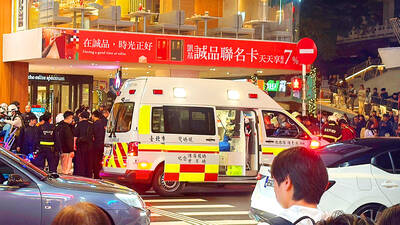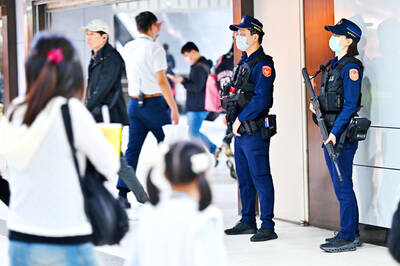Australia yesterday rejected a proposal by a Washington-based think tank to base a nuclear aircraft carrier strike group on Australia’s west coast as part of a shift of US military might to the Asia-Pacific region.
A Pentagon-commissioned report by the Center for Strategic and International Studies on repositioning US forces in the region suggested relocating an aircraft carrier from the US east coast to an Australian naval base south of the city of Perth.
However, Australian Defense Minister Stephen Smith said yesterday that while negotiations were under way to increase US navy access to Australia’s Indian Ocean base, HMAS Stirling, it would never become a US military base.
“We have made it crystal clear from the first moment — we don’t have United States military bases in Australia. We don’t see the need for that,” Smith told Australian Broadcasting Corp.
Smith said the think tank’s proposal was not endorsed by the US government.
The report said more than US$1 billion would need to be spent to make HMAS Stirling capable of becoming a home port to a nuclear carrier that would become the flagship of a carrier strike group.
Such a group would typically include two guided missile cruisers, two or three guided missile destroyers, two nuclear-powered submarines, a supply ship and up to nine squadrons of aircraft.
The Australian base would give the US a second carrier strike group in the Asia-Pacific region, the first with an existing Japanese home port in Yokosuka.
Washington has been forging closer military ties with countries in the region and has announced that 60 percent of the US Navy’s fleet will be based in the Asia-Pacific by 2020, up from less than 55 percent now.
Australia is a staunch US ally and the only country to fight alongside the US in every major conflict since the start of the 20th century.
China — Australia’s most important trade partner — has blasted the closer bilateral military ties as a return to Cold War divisions that risked the peace and security of the region.
Australian National University’s Strategic and Defense Studies Center head Hugh White said that US combat troops had not been based in Australia since World War II and that the situation was unlikely to change.
He said Chinese objections were the major reason why Australia was unlikely to ever allow US bases on its soil.
“The [Australian] government was surprised that China reacted as negatively as it has to the decision to have [US] Marines rotate deployments through Darwin, and I think they’ll be very careful not to risk further displeasure from China by doing anything that suggests they’re supporting a US military buildup in Asia,” White said.
“There’s a concern that the more the US builds up its military posture in the Western Pacific as part of [US] President Barack Obama’s pivot to Asia, the higher the risk that the US-China relationship will become more competitive, more adversarial, more hostile, and that pushes Australia close to the point of having to make a choice between the US and China, and that’s something we badly want to avoid,” he said.

TRAGEDY STRIKES TAIPEI: The suspect died after falling off a building after he threw smoke grenades into Taipei Main Station and went on a killing spree in Zhongshan A 27-year-old suspect allegedly threw smoke grenades in Taipei Main Station and then proceeded to Zhongshan MRT Station in a random killing spree that resulted in the death of the suspect and two other civilians, and seven injured, including one in critical condition, as of press time last night. The suspect, identified as a man surnamed Chang Wen (張文), allegedly began the attack at Taipei Main Station, the Taipei Fire Department said, adding that it received a report at 5:24pm that smoke grenades had been thrown in the station. One man in his 50s was rushed to hospital after a cardiac arrest

SAFETY FIRST: Double the number of police were deployed at the Taipei Marathon, while other cities released plans to bolster public event safety Authorities across Taiwan have stepped up security measures ahead of Christmas and New Year events, following a knife and smoke bomb attack in Taipei on Friday that left four people dead and 11 injured. In a bid to prevent potential copycat incidents, police deployments have been expanded for large gatherings, transport hubs, and other crowded public spaces, according to official statements from police and city authorities. Taipei Mayor Chiang Wan-an (蔣萬安) said the city has “comprehensively raised security readiness” in crowded areas, increased police deployments with armed officers, and intensified patrols during weekends and nighttime hours. For large-scale events, security checkpoints and explosives

A car bomb killed a senior Russian general in southern Moscow yesterday morning, the latest high-profile army figure to be blown up in a blast that came just hours after Russian and Ukrainian delegates held separate talks in Miami on a plan to end the war. Kyiv has not commented on the incident, but Russian investigators said they were probing whether the blast was “linked” to “Ukrainian special forces.” The attack was similar to other assassinations of generals and pro-war figures that have either been claimed, or are widely believed to have been orchestrated, by Ukraine. Russian Lieutenant General Fanil Sarvarov, 56, head

PUBLIC SAFETY: The premier said that security would be tightened in transport hubs, while President Lai commended the public for their bravery The government is to deploy more police, including rapid response units, in crowded public areas to ensure a swift response to any threats, President William Lai (賴清德) said yesterday after a knife attack killed three people and injured 11 in Taipei the previous day. Lai made the remarks following a briefing by the National Police Agency on the progress of the investigation, saying that the attack underscored the importance of cooperation in public security between the central and local governments. The attack unfolded in the early evening on Friday around Taipei Main Station’s M7 exit and later near the Taipei MRT’s Zhongshan